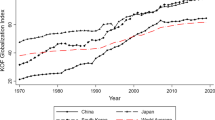Abstract
Contrary to Bourdieu’s theory (Distinction: A social critique of the judgment of taste. Cambridge, Massachusetts: Harvard University Press (1984)) that cultural consumption of so-called “high” versus popular culture is determined by socio-economic class, Peterson (Poetics 21:243–258, 1992; Poetics 33:257–282, 2005) finds that higher income and education groups are more likely to be “cultural omnivores”—consumers of a wide variety of both high and popular cultural goods. Omnivores were also found to be much less likely to exclude other cultures and to be more open to, and tolerant of, the views of others than those with narrower cultural tastes, called “cultural univores”. This article investigates the omnivore/univore hypothesis in a South African context, using survey data collected from 500 attendees of live theatre performances at the National Arts Festival in 2008. Multiple correspondence analysis (also called perceptual mapping) shows an interesting intermediate state between Boudieu-like high culture univores and Peterson omnivores, which could have interesting implications for the development of social tolerance in multi-cultural South Africa.

Similar content being viewed by others
Notes
The antilog of the coefficient gives the odds ratio, while the percentage change in the odds can be given by subtracting 1 from the antilog and multiplying by 100.
References
Abdi, H., & Valentin, D. (2007). Multiple correspondence analysis. In N. Salkind (Ed.), Encyclopedia of measurement and statistics. Thousand Oaks (CA): Sage.
Bourdieu, P. (1984). Distinction: A social critique of the judgment of taste. Cambridge, Massachusetts: Harvard University Press.
Bryson, B. (1996). Anything but heavy metal: Symbolic exclusion and musical dislikes. American Sociological Review, 61(5), 884–899.
Marais, L. (2004). Personal communication (Interview), 10/04, Grahamstown.
Maraun, M. D., Slaney, K., & Jalava, J. (2005). Dual scaling for the analysis of categorical data. Journal of Personality Assessment, 85(2), 209–217.
Neff, D. F. (2007). Subjective well-being, poverty and ethnicity in South Africa: Insights from an exploratory analysis. Social Indicators Research, 80, 313–341.
Peterson, R. (1992). Understanding audience segmentation: From elite and mass to omnivore and univore. Poetics, 21, 243–258.
Peterson, R. (2005). Problems in comparative research: The example of omnivorousness. Poetics, 33, 257–282.
Ronge, B. (2004). Mirrors of the mind. Sunday Times Magazine, 19/09/2004 Sunday Times, South Africa.
SAARF. (2002). SAARF Universal LSM: Living standards measure. Bryanston: South African Advertising Research Foundation Pub. AC Neilson Media International.
Snowball, J. (2005). Art for the masses? Justification for the public support of the arts in developing countries: 2 Arts festivals in South Africa. Journal of Cultural Economics, 29(2), 107–125.
Snowball, J. D. (2006). The economic valuation of cultural events in developing countries. Unpublished doctoral thesis: Rhodes University, South Africa.
Snowball, J., & Antrobus, G. (2004). The National Arts Festival Festino Survey 2004. Commissioned by the National Arts Festival, Grahamstown, South Africa.
Snowball, J., & Antrobus, G. (2006). The National Arts Festival Festino Survey 2006. Commissioned by the National Arts Festival, Grahamstown, South Africa.
Snowball, J. & Bragge, B. (2007). Why arts proponents love economic impact studies and cultural economists hate them. Presented at the 9th International Conference on Arts and Cultural Management, Valencia, Spain.
Sullivan, O. & Katz-Gerro, T. (2007). The omnivore thesis revisited: Voracious cultural consumers. European Sociological Review 23(2): 123–137.
Swanson, S., Davis, J., & Zhao, Y. (2008). Art for arts’ sake? An examination of motives for arts performance attendance. Non-profit and Voluntary Sector Quarterly, 37, 300–323.
Tampubolon, G. (2008). Revisiting omnivores in America circa 1990 s: The exclusiveness of omnivores? Poetics, 36, 243–264.
Van Eijck, K., & Leivens, J. (2008). Cultural omnivorousness as a combination of highbrow, pop, and folk elements: The relation between taste patterns and attitudes concerning social integration. Poetics, 36, 217–242.
Warde, A., Wright, D., & Gayo-Cal, M. (2007). Understanding cultural omnivorousness: Or, the myth of the cultural omnivore. Cultural Sociology, 1(2), 143–164.
Willis, K., & Snowball, J. (2009). Investigating how the attributes of live theatre productions influence consumption choices using conjoint analysis: The example of the National Arts Festival, South Africa. Journal of Cultural Economics, 33(3), 167–184.
Author information
Authors and Affiliations
Corresponding author
Rights and permissions
About this article
Cite this article
Snowball, J.D., Jamal, M. & Willis, K.G. Cultural Consumption Patterns in South Africa: An Investigation of the Theory of Cultural Omnivores. Soc Indic Res 97, 467–483 (2010). https://doi.org/10.1007/s11205-009-9513-y
Received:
Accepted:
Published:
Issue Date:
DOI: https://doi.org/10.1007/s11205-009-9513-y




